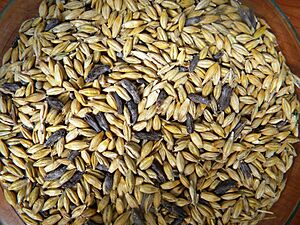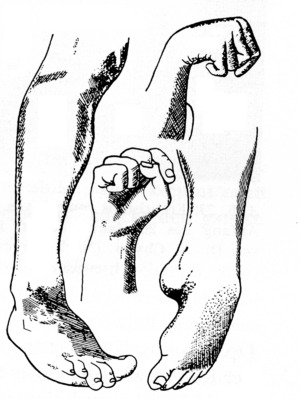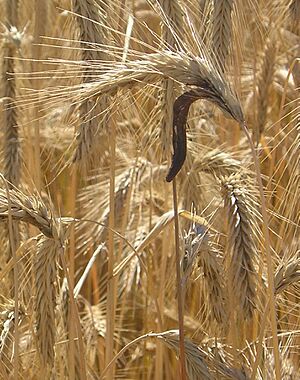Ergotism facts for kids
Quick facts for kids Ergotism |
|
|---|---|
| Synonyms | Saint Anthony's fire, ergotoxicosis |
| Symptoms |
|
| Types | Convulsive, gangrenous |
| Causes | Long-term poisoning from the ergot fungus |
Ergotism (pronounced UR-gut-iz-uhm) is a sickness caused by long-term poisoning from a fungus called Claviceps purpurea. This fungus can grow on rye and other grains used to make food like bread. When people eat contaminated grain over a long time, they can get very sick.
The illness is also known as ergot poisoning or, historically, as Saint Anthony's fire. The fungus produces harmful chemicals called alkaloids. These chemicals can also be found in certain types of medicines, which can cause similar problems if not used correctly.
Contents
What Are the Signs of Ergotism?
The symptoms of ergotism are caused by the harmful chemicals from the ergot fungus. These chemicals can tighten blood vessels, which reduces blood flow, and can also affect the brain. The symptoms are usually split into two types: convulsive and gangrenous.
Convulsive Symptoms
This type of ergotism affects the nervous system. People with convulsive ergotism might experience:
- Painful muscle cramps and seizures
- Diarrhea, nausea, and vomiting
- Tingling or itching skin
- Headaches
- Feelings of confusion, mania, or psychosis (losing touch with reality)
Usually, the stomach problems start before the effects on the brain and muscles.
Gangrenous Symptoms
This type of ergotism happens because the fungus's chemicals cause vasoconstriction, which is the tightening of blood vessels. This severely reduces blood flow to parts of the body, especially the fingers and toes.
Symptoms include:
- Skin peeling off
- A weak pulse in the hands and feet
- Loss of feeling in the fingers and toes
- Swelling
- In severe cases, the affected body parts can be permanently damaged due to lack of blood.
What Causes Ergotism?
The main cause of ergotism throughout history was eating food, especially bread made from rye, that was contaminated with the Claviceps purpurea fungus.
The fungus creates hard, dark growths called ergot bodies, which look like tiny, dark-colored grains. If these are not removed before the grain is milled into flour, the flour becomes poisonous.
The harmful chemicals in the ergot fungus can also be passed from a mother to her baby during breastfeeding.
How Can Ergotism Be Prevented?

Today, ergotism is very rare in developed countries because of modern farming and food safety methods. Here are some ways to prevent it:
- Cleaning the grain: Farmers can put harvested grain in a salt water solution. The healthy grains sink, while the lighter ergot bodies float to the top and can be skimmed off.
- Farming techniques: Ploughing fields deeply buries any ergot spores so they can't grow. Also, crop rotation (planting different crops in a field each year) helps stop the fungus from surviving, as its spores only live for about a year.
- Mowing nearby grasses: Cutting wild grasses before they flower can help stop the fungus from spreading.
Ergotism Throughout History
Ergotism was a serious problem for centuries, especially in Europe where rye was a common food.
One of the first recorded outbreaks was in the year 857. A chronicle described it as "a great plague of swollen blisters consumed the people by a loathsome rot, so that their limbs were loosened and fell off before death."
Saint Anthony's Fire
In the Middle Ages, the gangrenous form of ergotism was called "holy fire" or "Saint Anthony's fire." This was because people felt an intense burning sensation in their limbs.
It was named after the monks of the Order of St. Anthony, who became known for successfully treating people with the illness. They would give patients bread made from clean wheat, and their symptoms would often disappear.
The Salem Witch Trials Connection
Some historians have suggested that ergotism might explain the strange events of the Salem witch trials in 1692.
In 1976, a researcher named Linnda R. Caporael proposed a theory. She argued that the "bewitched" girls in Salem showed symptoms very similar to convulsive ergotism. These included muscle spasms, crawling sensations on the skin, headaches, and hallucinations. The weather conditions in the area at the time were also perfect for the ergot fungus to grow on rye, which was a local crop.
Arguments Against the Theory
However, many other historians disagree with this theory. They point out several problems:
- Ergotism usually affects a whole household that eats the same contaminated food, but in Salem, only certain individuals showed symptoms.
- Many classic symptoms of ergotism, like vomiting and diarrhea, were not reported in Salem.
- Convulsive ergotism is more common in people who lack vitamin A. The people of Salem were farmers with access to dairy products, so they likely had enough vitamin A.
Because of these points, most historians today do not believe that ergotism was the cause of the Salem witch trials. The debate shows how history can be looked at from different scientific and social points of view.
See also
- Dancing plague of 1518
- Great Fear



